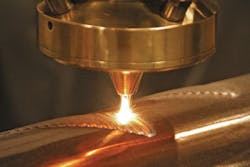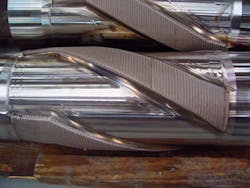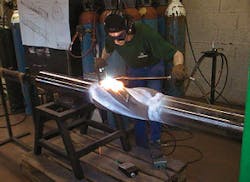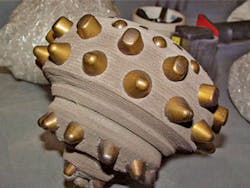New hard facing materials and corrosion-resistant alloys broaden the market for laser cladding services. Laser cladding, a type of laser surface alloying, is a process that precisely applies a uniform surface coating to tools and equipment, and provides protection against corrosion and wear without inducing magnetization.
The laser process involves fusing an alloy layer to a substrate with minimum melting of the substrate. The aim is to overlay and solidly bond one metal with another.1
Oil field tools are routinely subject to abrasion and corrosion, degrading their surface integrity both mechanically and chemically. The industry’s tools have become increasingly sophisticated, as engineers incorporate exotic base materials, and wear protection is ever more important to safeguard capital investments and keep projects on schedule.
Cladding is a less-expensive alternative to manufacturing tools, structural parts, and downhole components from solid corrosion-resistant or wear-resistant alloys. Applying a surface coating (hard facing) improves wear and corrosion resistance, results in longer component life, and keeps equipment in service longer. Cladding can be used to create an entirely new surface or it can repair and renew damaged or worn surfaces.
Laser cladding is particularly useful for protecting stabilizers and other drillstring components made of nonmagnetic steel. Laser-applied, tungsten carbide composites can provide the same protection against abrasion as carbide inserts, according to one supplier.2
Nonlaser approaches
Traditionally, hard facing was applied manually (stick-weld overlays) but this process is time-consuming and subject to non-uniformity or irregularities in surface cover. It also requires application of multiple layers, causing a thicker surface buildup. Furthermore, heating the base metal causes surface contaminants to seep into the weld pool, and electricity and heat induce magnetization in the object being clad.
Welding is cost-effective, however, for objects that are not required to be nonmagnetic, such as drillbits and bit shanks.
According to Mark Juckett, hardband product line manager at NOV Tuboscope’s global drill pipe services, MIG (metal inert gas) welding is the industry standard for applying hard facing (hardbanding) to drill pipe. The process can be automated, but requires an experienced welder to operate.
Oven sintering is another method of applying hard facing, but often repairs are not possible and the process is costly and time-consuming.
The hexavalent hard chrome plating method is also falling from favor due to the slowness of the coating process, need for multiple layers, lack of coating uniformity, and health and environmental concerns.3
A relatively newer, thermal spray application method, high velocity oxy-fuel (HVOF), has been used in the oil patch since 1995 to replace chrome plating, on items such as ball valves, hydraulic cylinder rods, mandrels, and risers and tensioner rods for offshore rigs.3
Components
Laser cladding is very complex, involving many processing parameters, such as power-beam spot size, feed rate, and powder flow. The process requires a high-powered laser, and sophisticated control and delivery systems (Fig. 1).
Many types of lasers are used, including CO2, Nd:YAG (yttrium aluminum garnet), diode, and fiber lasers. CO2 lasers are the most commonly used in laser cladding but the Nd:YAG laser’s wavelength is more appropriate for metal processing1 and a diode-laser cladding system can clad with half as much power as a CO2 laser.4 Sweden’s Duroc Engineering recently developed a portable, 4-kw fiber laser system that can be transported by helicopter offshore.5
Technogenia, based in Saint-Jorioz, France, began using a 5-kw CO2 laser for cladding in 1993, according to Herve Maybon, chief executive officer. The company began research on diode lasers in 2000 under European Craft Project No. 1, and installed new diode lasers in its plants in Sheffield, England, in 2003, Saint-Jorioz in 2005, and in Conroe, Tex., in 2007. [Technogenia diode laser pictured on front cover of this issue.]
Gremada Industries Inc., based in Fargo, ND, began offering laser cladding in 1994, according to Paul Phelan, sales engineer for Laser Cladding Services (LCS) Ltd. In 2001, Gremada opened LCS in Houston; the company runs both CO2 and more efficient diode lasers.
Newer lasers can incorporate robotic arms to maneuver complicated geometries.
Control systems are fundamental to laser cladding operations, often using multiaxis computer-numeric control (CNC) systems. A CNC system can be programmed to follow complex geometries, Phelan says.
Different material delivery systems can utilize powder (most common), wire, or fiber.
Materials
Commonly clad substrate materials include carbon steel, carbide composites, cobalt or nickel base super alloys, stainless steel, and titanium alloys. Oil field components are built using all of these and more.
Cobalt or nickel-based super alloys are often used in manufacturing and resurfacing of LWD (logging while drilling) and MWD (measurement while drilling) tools such as rotors, stators, impellors, drilling centralizers, erosion inserts, fishing heads, and landing, wear, and turbine sleeves (Fig. 2). These alloys are also used in mud-motor bearings, hydraulic cylinder rods, filter screens, kelly valve trim, cages, sucker rod couplings, annular blowout preventers, and subsurface safety valves (flappers, darts).
Many different hard-facing materials can be applied with laser cladding, but tungsten carbides are the most often used. It forms hard, tough coatings; carbides resist abrasion due to their hardness. Pure cast tungsten carbide spheres, which vary in size, form the wear component in a nickel-alloy matrix that is either formed into continuous, flexible welding rods (Fig. 3) or a powder for laser cladding. These spherical tungsten carbide mixtures are produced by a number of different companies, including spherotene from Technogenia.
Among the companies that provide materials for engineered surface coatings used in laser cladding are:
- Carpenter Powder Products, part of Carpenter Technology Inc., Bridgeville and Reading, Pa., and Torshälla, Sweden.
- Durum Verschleiss-Schutz GMBH, Willich, Germany.
- Stellite Coatings, part of Deloro Stellite Group, Goshen, Ind.
More complex alloys are used for surface enhancements, corrosion, and oxidation.
For instance, exposed portions of subsea riser supports made of commercial pipe with welded hanger flanges are laser clad with nickel-based alloys to add corrosion resistance to seawater.
Process
Laser cladding for the oil field is usually a single-stage application process that involves either pre-placing or blowing powdered cladding material on the substrate (object to be clad). The laser generates a molten pool in the presence of an inert gas. To cover a large surface, the laser must follow overlapping tracks. The resulting surface layer is usually 1-2 mm thick.6
Technogenia developed its Lasercarb process with the assistance of Irepa Laser in Strasbourg and the CALFETMAT research laboratory in Lyon. The process uses a computer-numeric control system to regulate temperature and power.
Although laser cladding imposes stresses on the material by the high local heat generated by the laser and the length of time required to complete multiple, overlapping passes across large surface areas, the heat input is still much lower than traditional weld overlay processes.
A two-stage laser cladding process exists that is limited to flat surfaces and is more prevalent in other industries.
Innovations
At the laser applications division of the Fraunhofer USA Center for Coatings and Laser Applications in Plymouth, Mich., researchers partner with Michigan State University on a variety of projects. Among the innovations was a laser-cladding method that uses a 3-kw diode laser and a coaxial powder-feeding nozzle to apply tungsten carbide.7 The diode process is one-third the cost of CO2 laser application and is successfully being used for downhole drilling equipment.
Laser-cladding research is also underway at the University of Waterloo, Ont.
Ehsan Toyserkani, in the university’s “mechatronics” engineering group, is working on measuring clad geometry microstructure in real-time, an essential control signal for a closed-loop control of laser cladding.
Toyserkani, Amir Khajepour, and Stephen Corbin, authors of a recent book on laser cladding,6 were awarded a patent in 2006 outlining a system and method for intelligent closed-loop control of laser cladding by powder injection.8
The researchers focused on improving the wear resistance of high-temperature turbine blades, but the methods are applicable to most oil field requirements.
Researchers in China are working on aluminum oxide (Al2O3) coatings on AZ91D magnesium alloy and 7075 aluminum alloy.9 10
Surface laser cladding with a CO2 laser was recently used to develop iron-based powder coatings containing nano-Al2O3 particles. Researchers found that adding nano-Al2O3 particles significantly improved mechanical properties, particularly wear resistance.11
Corrosion resistance is also a subject of current research, although in general practice, it’s common to use commercially available corrosion-resistant alloys in laser cladding. Russian researchers found that adding nickel to chromium cladding on stainless steel considerably enhanced pitting and corrosion resistance compared with surfaces clad with chromium alone.12
Other process innovations include:
- Advances in powder metallurgy and powder delivery systems.
- Using preheated wire instead of powder to increase speed and efficiency, reducing dust and waste.
- Incorporating an external energy source to preheat the substrate (induction heating).
- Technologies and automation to clad large surfaces efficiently.
Market, industry
Even operators such as ExxonMobil have worked on laser cladding, as shown in a review of US-issued patents. But laser cladding wasn’t widely commercialized until the mid-late 1990s.
Now, engineers at operating companies generally specify drilling requirements and service companies provide the specified equipment and services. Equipment manufacturers employ machine shops to build tools and arrange for specialty services such as laser cladding of certain components.
Laser cladding facilities are generally found in areas with heavy oil field demand, such as Texas and Alberta, as well in unexpected spots, such as the foothills of the French Alps, from which products are shipped worldwide.
According to Holger Stibbe, director of MWD/LWD development, Baker Hughes INTEQ uses a variety of proprietary wear resistant coatings and several laser cladding vendors. Different patterns are applied to improve wear resistance of MWD and LWD tools. Stibbe told OGJ that the availability of laser cladding services has improved in the last few years, with vendors in the US, France, and UK serving market needs. Baker uses predominantly CO2 lasers and some diode lasers.
At the Offshore Technology Conference this past May, Houston’s Laser Cladding Services discussed its partnership with NASA to develop specialized laser cladding for a control valve on a rocket engine test stand in NASA’s rocket engine testing program at the Stennis Space Center in Mississippi.13
Phelan told OGJ that the majority of the company’s work is for the oil industry, and the laser process is used for choke and kill lines, downhole tools, ball bounce, hydraulic cylinder rods-even the occasional drillbit (Fig. 4).
Laser cladding is useful wherever components need to be protected from abrasion, cavitation, fretting, particle erosion, and corrosion. Many of the world’s largest oil field equipment designers and manufacturers-including Baker Hughes INTEQ, Halliburton, NOV Tuboscope, Schlumberger, and Smith International-use some level of laser cladding.
References
- Gedda, Hans, “Laser surface cladding-A literature survey,” Technical Report 7, Lulea Tekniska Universitet, Mar. 22, 2000.
- Praxair Technology Inc., “Laser hardfacing,” www.praxair.com.
- Moore, Scott, “Hard Chrome Plating...Its Past, Present and Future,” Products Finishing Online, December 2003, www.pfonline.com.
- Kincaid, Kathy, “Optoelectronic applications: Materials Processing - Diode lasers test their mettle in surface treatment,” Laser Focus World, Dec. 1, 2006.
- “Overlay Welding: Transportable laser cladding system adapted for hazardous areas,” Offshore Magazine, Vol. 66, Issue 10, October 2006.
- Toyserkani, Ehsan, Khajepour, Amir, and Corbin, Stephen F., “Laser Cladding,” CRC Press, 2004, 280 pp.
- Groth, A., Walz, C., and Naegeler, S. “New Innovations in diode laser cladding,” www.ccl.fraunhofer.org/download/ innovations_in_diode_laser_cladding.pdf.
- Toyserkani, E., Khajepour, A., and Corbin, S.F., “System and method for intelligent closed-loop control of laser cladding by powder injection,” US Patent No. 7043330, May 9, 2006.
- Jun, Yao, Sun, G., Liu, C., Jia, S., and Fang, S., “Characterization and wear resistance of laser surface cladding AZ91D alloy with Al + Al2O3,” Journal of Materials Science, Vol. 42, No. 10, May 2007, pp. 3,607-3,612.
- Yue, T.M., Huang, K.J., and Man, H.C., “In situ laser cladding of Al2O3 bearing coatings on aluminum alloy 7075 for improvement of wear resistance,” Surface Engineering, Vol. 23, No. 2, March 2007 , pp. 142-146.
- Yu, S.i.r.o.n.g., Liu, Yan, Ren, Luquan, and Li, Wen, “Development of Laser-Cladding Layers Containing Nano-Al2O3 Particles for Wear-Resistance Materials,” Metallurgical and Materials Transactions A, Vol. 37, No. 12, December 2006 , pp. 3,639-3,645.
- Mudali, U., Kamachi, Kaul R., Ningshen, S., Ganesh, P., Nath, A.K., Khatak, H.S., and Raj, Baldev, “Influence of laser surface alloying with chromium and nickel on corrosion resistance of type 304L stainless steel,” Materials Science and Technology, Vol. 22, No. 10, October 2006, pp. 1,185-1,192.
- “Laser Cladding details laser coating breakthrough,” May 2, 2007, www.energycurrent.com.





